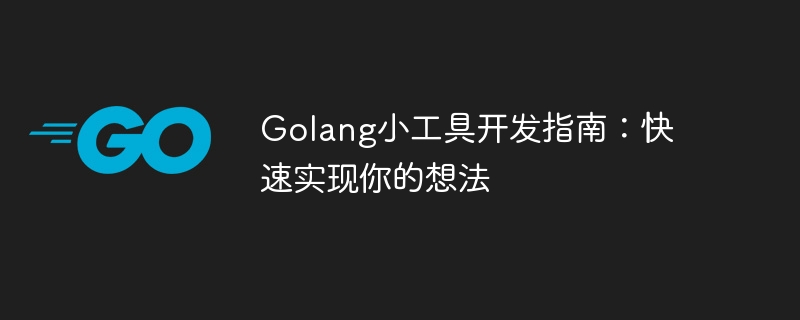Home >Backend Development >Golang >Golang Gadget Development Guide: Quickly Implement Your Ideas
Golang Gadget Development Guide: Quickly Implement Your Ideas
- PHPzOriginal
- 2024-03-19 08:42:04907browse

In today's fast-paced software development environment, it is crucial for programmers to quickly transform ideas into practical, usable tools or applications. As an efficient, concise and highly concurrency programming language, Golang is very suitable for rapid development of gadgets. This article will introduce you how to use Golang to quickly implement your ideas, and use specific code examples to help you get started quickly.
1. Preparation
Before you start, you need to make sure that Golang is installed on your computer. You can visit the Golang official website (https://golang.org/) to get the latest installation guide. After the installation is complete, you can verify whether the installation was successful by entering go version in the command line window.
2. Create a new project
First, we need to create a new Golang project to start our tool development. In the command line, use the mkdir mytool command to create a folder named mytool and enter the folder.
mkdir mytool cd mytool
Next, we need to initialize a new Golang module. Execute the following command in the current directory:
go mod init mytool
This will create a go.mod file to manage the dependencies of our project.
3. Write a code example
Next, let us write a simple example code to implement a small tool with simple functions. Suppose we want to develop a command line tool that converts input text to uppercase.
Create a file named main.go in the mytool folder and enter the following code:
package main
import (
"bufio"
"fmt"
"os"
"strings"
)
func main() {
reader := bufio.NewReader(os.Stdin)
fmt.Print("Please enter the text to be converted: ")
text, _ := reader.ReadString('
')
text = strings.ToUpper(text)
fmt.Println("Converted text: ", text)
}4. Build and run
After we finish writing the code, we can use the following command to build and run our gadget:
go build ./mytool
After entering the text and pressing the Enter key, you will see the converted uppercase text output in the command line.
5. Extended functions
In addition to simple text conversion tools, you can also extend the functions of the tool according to your own ideas. For example, you can add functions such as command line parameter parsing, file reading and writing, and network requests. Golang provides a wealth of standard libraries and third-party packages, which can simplify our implementation of various functions.
Conclusion
With the guidance in this article, you should now have a basic understanding of how to use Golang to quickly implement your ideas. With Golang's efficiency and simplicity, you can turn your ideas into practical tools or applications faster. I hope this article can help you start your Golang gadget development journey!
The above is the detailed content of Golang Gadget Development Guide: Quickly Implement Your Ideas. For more information, please follow other related articles on the PHP Chinese website!

